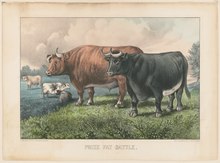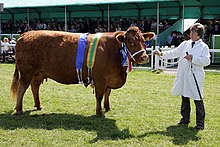



Feeder cattle, in some countries or regions called store cattle, are young cattle mature enough either to undergo backgrounding or to be fattened in preparation for slaughter. They may be steers (castrated males) or heifers (females who have not dropped a calf). The term often implicitly reflects an intent to sell to other owners for fattening (finishing). Backgrounding occurs at backgrounding operations, and fattening occurs at a feedlot.[1] Feeder calves are less than 1 year old; feeder yearlings are between 1 and 2 years old. Both types are often produced in a cow-calf operation. After attaining a desirable weight, feeder cattle become finished cattle that are sold to a packer (finished cattle are also called fattened cattle, fat cattle, fed cattle, or, when contrasted with carcasses, live cattle). Packers slaughter the cattle and sell the meat in carcass boxed form.[2]
Feedlots producing live cattle for slaughter will typically purchase 500–850 pounds (230–390 kg) feeder cattle calves and feed to grow the animals into 850–1,400 pounds (390–640 kg) cattle.[3][2] Backgrounding operations will typically purchase 300–600 pounds (140–270 kg) feeder cattle calves and feed to grow the animals into 650–875 pounds (295–397 kg) backgrounded cattle. Backgrounding cattle that achieve weights of 650–700 pounds (290–320 kg) are suitable for sale to grass feeding operations, whereas those achieving weights of 800–825 pounds (363–374 kg) are suitable for sale to feedlot operators.[4] Buyers of feeder cattle tend to look for high average gain (in weight) and low feed-to-gain ratio. Depending on circumstances, different feeder cattle buyers will look for different ranges of animal weight and grade.[5]
Cattle producers and backgrounding operations balance feeder cattle prices, weights, time taken to fatten, death rates, and other feeder cattle factors against feed prices, live cattle prices, and other operating factors to profit from their operations.[6][4]
- ^ "Backgrounding Feeder Cattle Nutrition". Agriculture Knowledge Centre. Government of Saskatchewan. Retrieved 2020-05-10.
- ^ a b Petricca, Frank (2017-10-16). "Fats vs feeders, off to a decent start". AgUpdate. Retrieved 2020-05-07.
- ^ CME Group. "An Introduction to Cattle Feeding Spreads" (PDF). Retrieved 2020-05-06.
- ^ a b "Backgrounding Feeder Cattle Nutrition". Agriculture Knowledge Centre. Government of Saskatchewan. Retrieved 2020-05-07.
- ^ Lewandowski, Rory. "What Do Feedyards Look for In Feeder Cattle?". Beef Magazine. Retrieved 2020-05-11.
- ^ "Understanding the Cattle Market Sliding Scale". Government of Alberta. Retrieved 2020-05-07.
© MMXXIII Rich X Search. We shall prevail. All rights reserved. Rich X Search
